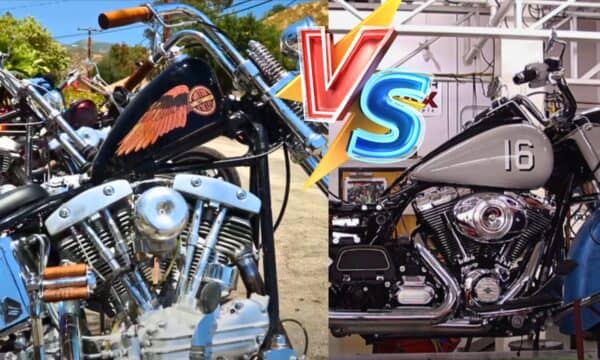Shovelhead and Twin Cam are types of engines used in Harley-Davidson motorcycles, one of the most popular motorcycle brands in the world.

The Shovelhead, named for its shovel-like shape, was used from 1966 to 1984 and is known for its raw power and classic design.
The Twin Cam, on the other hand, was used from 1999 to 2017 and is known for its improved performance and smoother ride.
In this article, I’ll help you understand the characteristics, differences, and similarities between these two iconic engine designs.
Let’s begin!
Shovelhead VS Twin Cam
The Shovelhead and Twin Cam are different types of motorcycle engines made by Harley-Davidson.
The Shovelhead was named because of its distinct cover that looked like a coal shovel.
On the other hand, the Twin Cam, which started production in 1999, has two camshafts and is known for being more reliable and powerful than the Shovelhead.
However, some people still love the Shovelhead for its vintage look and classic feel.
Historical Context and Development
In 1966 the Shovelhead engine got its name from the distinct shape of the rocker covers, which resembled a coal shovel’s head.
The Shovelhead era saw the introduction of hydraulic valve lifters and an electric start system, both monumental advancements in Harley-Davidson’s evolution.
This engine was praised for its improved power and performance, and it remained in production until 1984.
On the other hand, the Twin Cam was introduced in 1999. It offered significant enhancements in power, torque, and reliability, due to key advancements such as dual camshafts and fuel injection.
However, it was somewhat controversial due to initial problems with the chain-driven cams, which were later resolved.
The Twin Cam also saw the introduction of the rubber-mounted Softail frame and a 6-speed transmission.
This engine was in production until 2016 when it was replaced by the Milwaukee-Eight engine.
These two engines represent substantial periods of technological progress and design evolution for Harley-Davidson.
Technical Specifications
When examining the technical specifications of these engines, a few distinctions are of note.
The Shovelhead is an air-cooled, two-valve per-cylinder V-twin engine. Its name was derived from the shovel shape of the rocker covers.
The engine displacement ranged from 1200cc to 1340cc, yielding a power output of 60 to 70 horsepower.
On the other hand, the Twin Cam boasts two cams, offering improved engine performance.
The Twin Cam has seen variations in displacement from 88 cubic inches (1450cc) to 110 cubic inches (1800cc) generating a power output ranging from 80 to 100 horsepower.
This engine was designed to meet stricter emission standards and provide better engine cooling and increased reliability.
The Shovelhead offers simplicity and ease of maintenance, while the Twin Cam presents technological advancements.
Performance and Reliability
The Shovelhead and Twin Cam both possess distinct characteristics in terms of performance and reliability.
When it comes to power and efficiency, the Shovelhead may not match the Twin Cam.
The Twin Cam provides more torque and fuel efficiency, with its advanced engine design; which enhances the motorcycle’s power output.
So, when we talk about the Shovelhead, its simpler design often requires less frequent maintenance.
However, the Twin Cam tends to have a longer lifespan, assuming proper maintenance, due to its modern engineering.
Riding Experience
In terms of riding experience, both engines provide distinctly different feels due to their unique characteristics.
The Shovelhead engine is known for its raw power and robustness and offers an authentically vintage riding style.
Its unique charm lies in the rumbling sound and vibration it produces, which delivers a visceral and tactile sensation that many riders appreciate.
On the other hand, the Twin Cam engine is renowned for its smoother performance and enhanced reliability and offers a more refined riding experience.
Its power delivery is more consistent and controlled, which makes it suitable for riders who prefer comfort and efficiency.
In terms of maintenance, Twin Cam engines generally require less frequent attention than Shovelheads.
Cultural Impact and Legacy
The Shovelhead cultivated a rugged, free-spirited aura around the bikers who rode them, with rugged design and raw power.
This engine, became a symbol of rebellion, igniting a subculture that revered their bikes as an extension of their personality.
On the other hand, the Twin Cam represents the evolution and progression of motorcycle engineering.
Emphasizing efficiency, reliability, and modern aesthetics, it appealed to a new generation of riders who valued cutting-edge technology and performance.
This engine captures the essence of motorcycling – freedom, thrill, and a culture that values tradition and innovation.
The Twin Cam’s influence is evident in today’s motorcycle designs, shaping the expectations and preferences of modern riders.
Is a Shovelhead a Big Twin?
Yes, a Shovelhead is a type of Big Twin. In simple terms, Shovelhead is a nickname for a kind of engine that was used in Harley-Davidson motorcycles.
The term “Big Twin” is used to describe the larger engines made by Harley-Davidson.
So, when we say a Shovelhead is a Big Twin, it means that the Shovelhead engine is one of the larger types of engines that Harley-Davidson made.
Are Shovelhead Engines Reliable?
Yes, Shovelhead engines are reliable. They are a type of engine used in motorcycles and they are known for being strong and sturdy.
While they might need some maintenance as they get older, if they are properly cared for, they can run smoothly for a long time.
Editor’s Thinking
Both the Shovelhead and Twin Cam engines have their unique attributes and appeal.
The Shovelhead is admired for its classic and raw mechanical design, while the Twin Cam is known for its improved power and reliability.
The choice ultimately depends on personal preference, considering maintenance, performance requirements, and aesthetic appeal.
You can also read the comparisons of Parallel Twin vs. Inline-twin, Milwaukee 107 Vs 103, Milwaukee 107 vs 114, Parallel-twin vs V-twin and the major differences between V6 and 6-cylinder engines.

Ahtsham Younas is a passionate blogger and content writer. He loves to ride motorcycles and learn the mechanical process behind the motorcycles.
He has been writing articles in the motorcycle industry since 2019 and has learned many things about motorbike niches.


